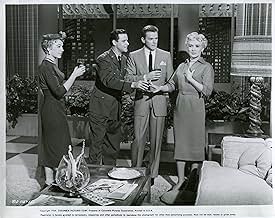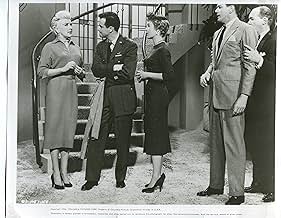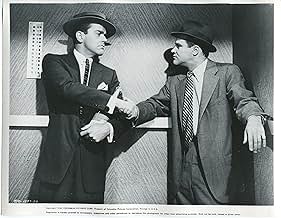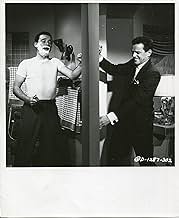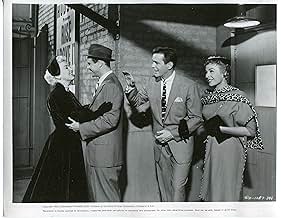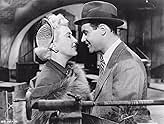NOTE IMDb
6,1/10
513
MA NOTE
Ajouter une intrigue dans votre langueA widowed singer marries her deceased husband's songwriting partner which leads to trouble when her former husband turns up very much alive.A widowed singer marries her deceased husband's songwriting partner which leads to trouble when her former husband turns up very much alive.A widowed singer marries her deceased husband's songwriting partner which leads to trouble when her former husband turns up very much alive.
- Réalisation
- Scénario
- Casting principal
David Ahdar
- Male Harem Dancer
- (non crédité)
Leon Alton
- Stage Manager
- (non crédité)
Tom Anthony
- Bit Role
- (non crédité)
Robert Bice
- Sgt. Charlie O'Hallihan
- (non crédité)
Bill Boes
- Male Harem Dancer
- (non crédité)
Eugene Borden
- Costume Designer
- (non crédité)
Johnny Brazil
- Male Harem Dancer
- (non crédité)
Eddie Brown
- Male Harem Dancer
- (non crédité)
George Bruggeman
- Male Harem Dancer
- (non crédité)
Aileen Carlyle
- Mother
- (non crédité)
Beulah Christian
- Wardrobe Woman
- (non crédité)
Gene Dailey
- Male Harem Dancer
- (non crédité)
John David
- Male Harem Dancer
- (non crédité)
Avis à la une
What an interesting pedigree Three For The Show had, dating all the way back to 1920 when W. Somerset Maugham's play Too Many Husbands debuted on Broadway with a long forgotten cast. It had a military background instead of a show business one, though the military does figure prominently in the plot.
Collaborators Jack Lemmon and Gower Champion have a hit show on Broadway for producer Myron McCormick that stars Betty Grable. Lemmon goes into the Air Force during the Korean War and goes MIA. He's reported killed and Grable who was married to Lemmon, now marries Champion. Then of course Lemmon returns and they've a situation the reverse of My Favorite Wife.
In the meantime poor Marge Champion is champing at the bit because she's got a thing for Gower. I think you can figure out where this one is going.
The numbers come from a variety of sources, some original, some Broadway, some classical. Betty Grable in what proved to be her next to last film did more serious type dancing here than in any other. But next to the Champions, she really did not look that good. It was unfair to cast her with them.
Grable also did not like working for Harry Cohn, she was used to another imperious studio mogul over at 20th Century Fox who had kind of eased her out of her number one spot for the fast rising Marilyn Monroe. But she thought he was a pussycat next to Cohn. Two For The Show was Betty's first outside film after 14 year at Fox.
Jack Lemmon proved to have a couple of good singing notes as he does accompany the rest on a number or two. He liked working with Grable because he felt she was unpretentious with a good sense of humor as apparently a lot of her colleagues did.
As a film though, Three For The Show will never rank first rate in the work of either Lemmon or Grable.
Collaborators Jack Lemmon and Gower Champion have a hit show on Broadway for producer Myron McCormick that stars Betty Grable. Lemmon goes into the Air Force during the Korean War and goes MIA. He's reported killed and Grable who was married to Lemmon, now marries Champion. Then of course Lemmon returns and they've a situation the reverse of My Favorite Wife.
In the meantime poor Marge Champion is champing at the bit because she's got a thing for Gower. I think you can figure out where this one is going.
The numbers come from a variety of sources, some original, some Broadway, some classical. Betty Grable in what proved to be her next to last film did more serious type dancing here than in any other. But next to the Champions, she really did not look that good. It was unfair to cast her with them.
Grable also did not like working for Harry Cohn, she was used to another imperious studio mogul over at 20th Century Fox who had kind of eased her out of her number one spot for the fast rising Marilyn Monroe. But she thought he was a pussycat next to Cohn. Two For The Show was Betty's first outside film after 14 year at Fox.
Jack Lemmon proved to have a couple of good singing notes as he does accompany the rest on a number or two. He liked working with Grable because he felt she was unpretentious with a good sense of humor as apparently a lot of her colleagues did.
As a film though, Three For The Show will never rank first rate in the work of either Lemmon or Grable.
If you have managed to somehow miss this musical, watching it 60+ years after it was released is a revelation. Betty Grable's appeal makes sense to me at last, in this her last major film at the age of 39. The plot in a nutshell: A successful performer has been widowed by World War II. She marries her late husband's songwriting partner, played by Gower Champion, but the new marriage becomes a racy ménage a trois when her first husband, played by Jack Lemmon, shows up alive and eager to claim his conjugal rights. Grable plays her cards right, through a series of dreamy song and dance sequences with music by George and Ira Gershwin, Cole Porter, and Hoagy Carmichael. The extraordinary dance team of Marge and Gower Champion has never looked better, nor have "Someone to Watch Over Me," "Just One of Those Things," and "I've Got a Crush on You" ever sounded better. Some critics say Grable imitated Marilyn Monroe; I prefer to think that her performance was a gesture of handing over the "Hollywood's hottest blonde" crown to Monroe and quitting while she was ahead, which she definitely was in this film. Favorite line from Grable: I've got what most women want-a lover and a husband and they're both legal!"
..and with Marge and Gower Champion and Jack Lemmon...it is lots of fun. Fun is what Betty Grable was about...and this film is at its best during those sequences aimed at amusing. ...These days people do not understand Betty Grable very well. In her day she was everyman's and every womans ideal. Indeed no woman has broken Betty's box office record (eleven years in the top ten). And, in the forties and early fifties, women still dominated the box office to an amazing degree--Mom chose the films the family was going out to see. Though it was a bit early to be obvious, Betty in many ways represented a manifestation of what we would now call a liberated woman. She was nearly always working (in revealing clothing!), and she was self supporting. In real life she was a very successful working mother--and particularly during WWII she was an inspiration to women manning the homefront as much as an inspiration to the armed forces fighting overseas. She was pretty, talented, popular, and the highest salaried woman in the United States. Now she is remembered primarily as a 'pin up'--which she also was, but the title tends to diminish the many other factors that created her popularity. One thing is certain, in "Three for the Show" or any other of her starring films--she will entertain you royally within the limitations of the material she was given.
Musical version of 1940's "Too Many Husbands", via W. Somerset Maugham's play "Home and Beauty" (which the author said he wrote as a lark), has widowed--and remarried--Broadway star in a marital quandary: her first husband's death overseas was misreported by the US Air Force (he was actually marooned on an island), and now she has two husbands...and both marriages legal! Betty Grable toys with the possibilities--she even fantasizes a musical number with dozens of suitors housed in cages, climaxing with she and her two husbands under the sheets smoking a hookah! But, this being 1955, we instead have Betty ordering both her husbands out of her boudoir come bedtime. The plot predicament, not surprisingly, doesn't come to much, but in the interim we have some bright moments, not the least of which is Grable's Marilyn Monroe-like delivery in the final number, "How Come You Do Me Like You Do" (which sounds a lot like MM's "Lazy" with a design resembling her "Heat Wave"). Director H. C. Potter opens the picture with a berserk pantomime number danced to "Someone To Watch Over Me" (in harlequin costumes!), but he gets good performances from both Grable and Jack Lemmon (who also sings a little and dances a bit). As the second couple, Marge and Gower Champion dance nicely together but don't have much pizzazz, much like the rest of "Three For the Show". A pleasant marquee-filler but hardly a headliner. **1/2 from ****
Betty Grable was 39 when she made this film, her last to be released, and her constant references to herself as a girl seem peculiar. Even more disturbing is the way she imitates the singing style of Marilyn Monroe in her numbers. She had just made "How To Marry a Millionaire" with Monroe and had commented that she felt she was handing her crown on to Monroe. But to see the great star Grable trying to be Monroe is a little sad.
The film itself is a mess of a thing - some good dance numbers featuring Marge and Gower Champion (Marge's fantasy sequence is very fine) and some good songs ("I've Got a Crush On You", "Someone to Watch Over Me")sit uncomfortably with the plot and the director never seems sure which style he is aiming for. It looks like an attempt to cover the breezy free style of the Gene Kelly/Stanley Donen musicals, with characters bursting into song all over the place and elaborate dance dream sequences. But the result is a confusion of styles and a plodding pace.
The plot concerns married Grable discovering her presumed dead first husband is still alive. She must then choose between new husband Gower Champion and old husband Jack Lemmon (who also happen to be a show writing team). This potentially serious situation, that probably occurred a lot after the war, is treated completely flippantly - and with Gower's real life wife hanging around it's not hard to guess how things will turn out. Lemmon is good, but looks uncomfortable singing and dancing. See this for the numbers - but make sure you see it in Cinemascope.
The film itself is a mess of a thing - some good dance numbers featuring Marge and Gower Champion (Marge's fantasy sequence is very fine) and some good songs ("I've Got a Crush On You", "Someone to Watch Over Me")sit uncomfortably with the plot and the director never seems sure which style he is aiming for. It looks like an attempt to cover the breezy free style of the Gene Kelly/Stanley Donen musicals, with characters bursting into song all over the place and elaborate dance dream sequences. But the result is a confusion of styles and a plodding pace.
The plot concerns married Grable discovering her presumed dead first husband is still alive. She must then choose between new husband Gower Champion and old husband Jack Lemmon (who also happen to be a show writing team). This potentially serious situation, that probably occurred a lot after the war, is treated completely flippantly - and with Gower's real life wife hanging around it's not hard to guess how things will turn out. Lemmon is good, but looks uncomfortable singing and dancing. See this for the numbers - but make sure you see it in Cinemascope.
Le saviez-vous
- AnecdotesMercury Records issued a 10-inch LP of the soundtrack, which would be the only contemporary soundtrack album released from a Betty Grable film.
- GaffesMartin 'Marty' Stewart appears in a U. S. Air Force uniform, yet several times in the movie various characters refer to him being in the U. S. Army.
- Citations
Gwen Howard: I wonder what kind of champagne I should order.
Vernon Lowndes: Depends what you're launching.
- ConnexionsFeatured in L'univers du rire (1982)
- Bandes originalesHow Come you Do Me Like You Do
Words and Music by Gene Austin and Ray Bergere
Performed by Betty Grable (uncredited)
Meilleurs choix
Connectez-vous pour évaluer et suivre la liste de favoris afin de recevoir des recommandations personnalisées
- How long is Three for the Show?Alimenté par Alexa
Détails
- Durée
- 1h 33min(93 min)
- Rapport de forme
- 2:55 : 1
Contribuer à cette page
Suggérer une modification ou ajouter du contenu manquant

